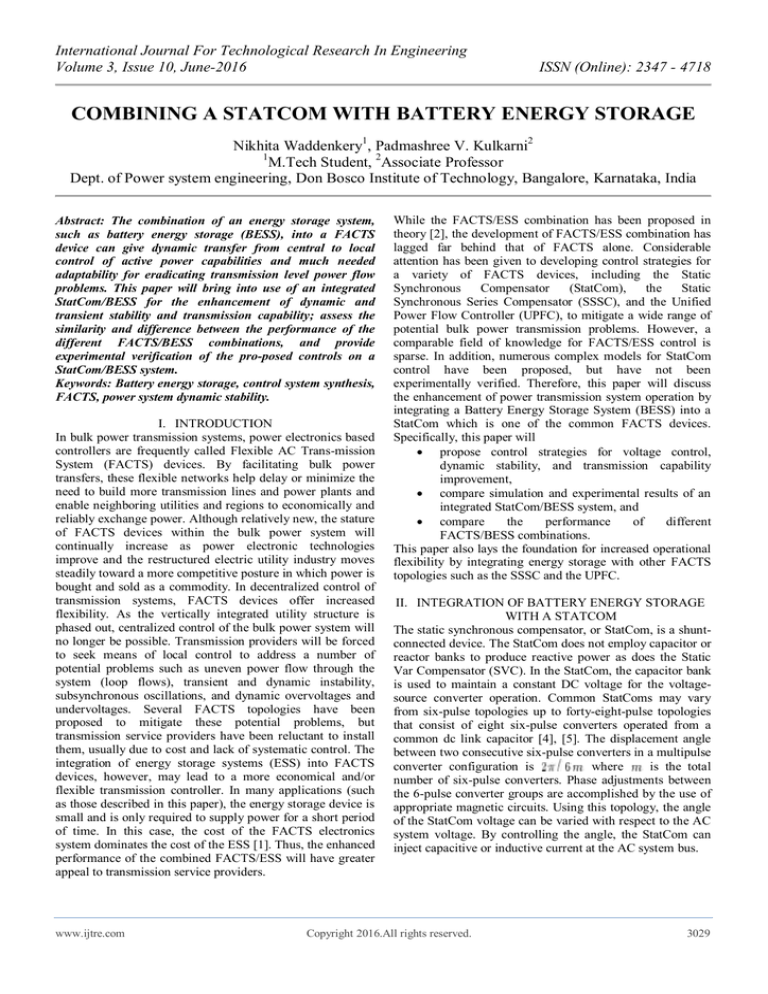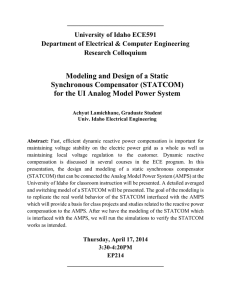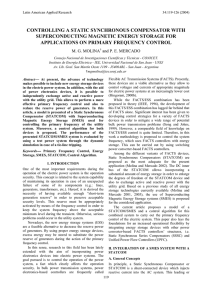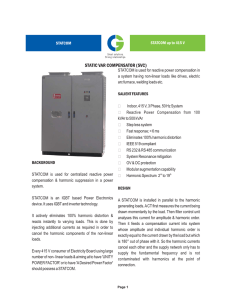
International Journal For Technological Research In Engineering
Volume 3, Issue 10, June-2016
ISSN (Online): 2347 - 4718
COMBINING A STATCOM WITH BATTERY ENERGY STORAGE
Nikhita Waddenkery1, Padmashree V. Kulkarni2
1
M.Tech Student, 2Associate Professor
Dept. of Power system engineering, Don Bosco Institute of Technology, Bangalore, Karnataka, India
Abstract: The combination of an energy storage system,
such as battery energy storage (BESS), into a FACTS
device can give dynamic transfer from central to local
control of active power capabilities and much needed
adaptability for eradicating transmission level power flow
problems. This paper will bring into use of an integrated
StatCom/BESS for the enhancement of dynamic and
transient stability and transmission capability; assess the
similarity and difference between the performance of the
different FACTS/BESS combinations, and provide
experimental verification of the pro-posed controls on a
StatCom/BESS system.
Keywords: Battery energy storage, control system synthesis,
FACTS, power system dynamic stability.
I. INTRODUCTION
In bulk power transmission systems, power electronics based
controllers are frequently called Flexible AC Trans-mission
System (FACTS) devices. By facilitating bulk power
transfers, these flexible networks help delay or minimize the
need to build more transmission lines and power plants and
enable neighboring utilities and regions to economically and
reliably exchange power. Although relatively new, the stature
of FACTS devices within the bulk power system will
continually increase as power electronic technologies
improve and the restructured electric utility industry moves
steadily toward a more competitive posture in which power is
bought and sold as a commodity. In decentralized control of
transmission systems, FACTS devices offer increased
flexibility. As the vertically integrated utility structure is
phased out, centralized control of the bulk power system will
no longer be possible. Transmission providers will be forced
to seek means of local control to address a number of
potential problems such as uneven power flow through the
system (loop flows), transient and dynamic instability,
subsynchronous oscillations, and dynamic overvoltages and
undervoltages. Several FACTS topologies have been
proposed to mitigate these potential problems, but
transmission service providers have been reluctant to install
them, usually due to cost and lack of systematic control. The
integration of energy storage systems (ESS) into FACTS
devices, however, may lead to a more economical and/or
flexible transmission controller. In many applications (such
as those described in this paper), the energy storage device is
small and is only required to supply power for a short period
of time. In this case, the cost of the FACTS electronics
system dominates the cost of the ESS [1]. Thus, the enhanced
performance of the combined FACTS/ESS will have greater
appeal to transmission service providers.
www.ijtre.com
While the FACTS/ESS combination has been proposed in
theory [2], the development of FACTS/ESS combination has
lagged far behind that of FACTS alone. Considerable
attention has been given to developing control strategies for
a variety of FACTS devices, including the Static
Synchronous
Compensator
(StatCom),
the
Static
Synchronous Series Compensator (SSSC), and the Unified
Power Flow Controller (UPFC), to mitigate a wide range of
potential bulk power transmission problems. However, a
comparable field of knowledge for FACTS/ESS control is
sparse. In addition, numerous complex models for StatCom
control have been proposed, but have not been
experimentally verified. Therefore, this paper will discuss
the enhancement of power transmission system operation by
integrating a Battery Energy Storage System (BESS) into a
StatCom which is one of the common FACTS devices.
Specifically, this paper will
propose control strategies for voltage control,
dynamic stability, and transmission capability
improvement,
compare simulation and experimental results of an
integrated StatCom/BESS system, and
compare
the
performance
of
different
FACTS/BESS combinations.
This paper also lays the foundation for increased operational
flexibility by integrating energy storage with other FACTS
topologies such as the SSSC and the UPFC.
II. INTEGRATION OF BATTERY ENERGY STORAGE
WITH A STATCOM
The static synchronous compensator, or StatCom, is a shuntconnected device. The StatCom does not employ capacitor or
reactor banks to produce reactive power as does the Static
Var Compensator (SVC). In the StatCom, the capacitor bank
is used to maintain a constant DC voltage for the voltagesource converter operation. Common StatComs may vary
from six-pulse topologies up to forty-eight-pulse topologies
that consist of eight six-pulse converters operated from a
common dc link capacitor [4], [5]. The displacement angle
between two consecutive six-pulse converters in a multipulse
converter configuration is
where
is the total
number of six-pulse converters. Phase adjustments between
the 6-pulse converter groups are accomplished by the use of
appropriate magnetic circuits. Using this topology, the angle
of the StatCom voltage can be varied with respect to the AC
system voltage. By controlling the angle, the StatCom can
inject capacitive or inductive current at the AC system bus.
Copyright 2016.All rights reserved.
3029
International Journal For Technological Research In Engineering
Volume 3, Issue 10, June-2016
Fig.1. Integrated StatCom with energy storage.
Although the ability of a StatCom to improve power system
performance has been well accepted, very little information
regarding its dynamic control has been published [6]. The
StatCom is best suited for voltage control since it may
rapidly inject or absorb reactive power to stabilize voltage
excursions [3], [4], [6], [7] and has been shown to perform
very well in actual operation [5]. Several prototype StatCom
installations are currently in operation [5], [8]. The ability of
the StatCom to maintain a pre-set voltage magnitude with
reactive power compensation has also been shown to
improve transient stability [6] and subsynchronous oscillation
damping [9]–[11]. However, a combined StatCom/ESS
system can provide better dynamic performance than a standalone StatCom. The fast, independent active and reactive
power support provided by an ESS coupled to a StatCom can
significantly enhance the flexibility and control of
transmission and distribution systems. The configuration of
an integrated StatCom/ESS is shown in Fig. 1. The traditional
StatCom (with no energy storage) has only two possible
steady-state operating modes: inductive (lagging) and
capacitive (leading). Although both the traditional StatCom
output voltage magnitude and phase angle can be controlled,
they cannot be independently adjusted in steady state since
the StatCom has no significant active power capability. Thus
it is not possible to significantly impact both active and
reactive power simultaneously. For the StatCom/ESS, the
number of steady state operation modes is extended to all
four quadrants. These modes are inductive with DC charge,
inductive with DC discharge, capacitive with DC charge, and
capacitive with DC discharge. Due to the nature of ESS, the
StatCom/ESS cannot be operated infinitely in one of the four
modes (i.e., the battery cannot continuously discharge);
therefore these modes represent quasi steady-state operation.
However, depending on the energy output of the battery or
other ESS, the discharge/charge profile is typically sufficient
to provide enough energy to stabilize the power system and
maintain operation until other long-term energy sources may
be brought on-line.
www.ijtre.com
ISSN (Online): 2347 - 4718
Fig.2. StatCom/BESS voltage characteristics.
Fig. 2 shows the steady state operational characteristics of
the StatCom/BESS output. Note that in steady state, the
output voltage of the traditional StatCom is in one dimension
only, and must lie along the dashed line, whereas the output
voltage of a StatCom/BESS can take on any value within the
circle. This gives the StatCom/BESS an additional degree of
operating freedom that provides the enhanced performance
and impact. The dashed line of the traditional StatCom
operational curve separates the StatCom/BESS operating
region into two regions. The upper right region represents the
BESS discharge area and the lower left region is the charging
area. The angles
and
are the maximum and minimum output
voltage angles of the StatCom/BESS. The angles
and
are the maximum and minimum output voltage angles
of the traditional StatCom. These angles are dependent on
the system voltage, equivalent impedance and the maximum
cur-rent limit of the StatCom/BESS. The maximum current
limit of the StatCom/BESS is determined by the maximum
transformer current, the maximum device current, and the
maximum output current of the BESS.
Fig.3. StatCom/BESS output power characteristics.
Fig. 3 illustrates the StatCom side and the system side active
and reactive power characteristics under constant terminal
voltage. The StatCom side is the converter side of the
transformer shown in Fig. 1. The two circles of radius Vsys
represent the possible output power of the StatCom
side (shaded region) and the system side. Note that the center
of the StatCom circle is shifted from the origin by
,
where
represents the equivalent impedance of the
StatCom and transformer. The dashed lines represent the
possible output power of the traditional StatCom. Note that
on the system side of the traditional StatCom (the dashed
arc), the active power is always negative to indicate that the
StatCom will always draw active power from the system to
Copyright 2016.All rights reserved.
3030
International Journal For Technological Research In Engineering
Volume 3, Issue 10, June-2016
compensate for any losses. Under ideal conditions, the
StatCom/BESS can be operated anywhere within the circular
region.
ISSN (Online): 2347 - 4718
fundamental). Current trends in the development of the
family of high-power, fast-switched IGBTs support the
future use of PWM control for transmission level
applications. In
the system reference, the dynamic
StatCom/BESS can be modeled as:
Fig.4. Experimental StatCom/BESS.
III. STATCOM/BESS CONTROL
The control objective of the StatCom/BESS is to maintain
system performance according to some pre-set or user
defined scheme. The control objective may be voltage
control, power flow control for oscillation damping, or
transient stability improvement. A control scheme for active
and reactive power flow control has been implemented on a
scaled laboratory StatCom/BESS system.
A. Experimental StatCom/BESS System
The experimental StatCom was interfaced with a battery set
that consists of 34 VLRA super-gel batteries in two strings
supplying 204 V dc. A data acquisition system was
constructed to monitor the battery voltage and string currents.
A signal interface board provides the digital and analog
isolation and converts the cur-rent signals into voltage signals
and filters the high-frequency noise. A bank of three-phase
150
F capacitors is used to filter the line-line
StatCom/BESS voltage output. The monitoring and control
system for the integrated StatCom/BESS system consists of
two M5000 boards; one for data acquisition and preprocessing and the other for PWM signal generation. The
A/D board measures the system frequency within 0.01 Hz. It
is also used to calculate various state variables such as , ,
, and
to export to the PC for the control
algorithm. It also provides error detection/correction and
digital filtering. The system controller is fully programmable
so that new controls can be implemented rapidly. The
StatCom/BESS is rated at 3 kVA. The experimental set-up is
shown in Fig. 4 and described in greater detail in [12].
B. Transmission Capacity Control
The development of transmission capacity control is based on
the assumption of pulse width modulated (PWM) switching
using triangle modulation, and a relatively high switching
frequency (63 switching cycles per period of the
www.ijtre.com
The controller provides an active and reactive power
command to achieve the desired system response. The
controller converts the commanded powers into PWM
switching commands for the StatCom to regulate the
modulation gain and angle. For optimal control of
transmission capacity, it is desired to have a controller that
can achieve independent active and reactive power response.
To accomplish this goal, a decoupled PI controller is
proposed which can produce the desired switching
commands from independent active and reactive power
commands. Since control is defined for a particular
StatCom/BESS, the system bus voltage angle may be taken
to be identically zero in the control without loss of
generality. Therefore the StatCom/BESS active power and
reactive power on the power system side can be calculated
in the reference frame coordinates as
Copyright 2016.All rights reserved.
3031
International Journal For Technological Research In Engineering
Volume 3, Issue 10, June-2016
ISSN (Online): 2347 - 4718
simulated control are shown concurrently with the
experimental results, where the solid lines indicate the
measured power dynamics and the dashed lines indicate the
predicted dynamics. The simulation results were obtained
from a detailed model of the laboratory system built in the
software package PSCAD. The simulation model used the
measured values of the laboratory parameters of the
StatCom/BESS system (transformer reactances, filter
capacitances, etc.).
Fig. 5. Decoupled PQ control.
Fig.7. Step change in active power
Fig.6. Step change in reactive power.
where realizing decoupled active and reactive power can be
achieved through decoupled
and control. At equilibrium,
there is no active power exchange between the StatCom and
battery, thus the first two rows of equation (1) may be
linearized to obtain:
Where
is the control variable vector. In the
StatCom/BESS connected system, the dc voltage
is held
nearly constant by the battery, therefore the incremental
change
is negligible. By combining equations (2)–(4),
a decoupled PI local controller for producing a PWM
modulation index and angle from a desired
and
command can developed as shown in Fig. 5. The
effectiveness of this control is illustrated in Figs. 6 and 7,
where the active and reactive powers are independently
commanded to make step changes. The results of the
www.ijtre.com
Fig. 8. Simultaneous step change of active and reactive
power from 0 to 1 kW and 1 kVar (respectively).
In Fig. 6, the reactive power is commanded to change from 0
to kVar (a step change of 0.17 per unit) while holding
the active power at zero. Similarly, Fig. 7 shows a 0.17 per
unit step change in active power while holding the reactive
power at zero. The corresponding change in current is 1.26
A. In both cases, the independent nature of the control is
evident, since a commanded change in one power causes
only a small response in the other. Both the active and
reactive powers achieved their target values within 0.1
seconds, which is the desired response time. Also the
simulated response predicts the experimental behavior very
well. The slight oscillation in both experimental responses is
due to the imbalance of the ac system voltages. The local
control was developed based on the assumption of a threephase balanced system. However, even in the case of system
imbalance (which occurs often in practice), the controller
responds well. The slight responses in the powers being held
at zero is due to the linearized control process, since the
Copyright 2016.All rights reserved.
3032
International Journal For Technological Research In Engineering
Volume 3, Issue 10, June-2016
active and reactive powers are not truly fully decoupled in
the nonlinear system. The controller was also tested on larger
commanded changes. Figs. 8 and 9 show the response of the
StatCom/BESS
Fig. 9. Simultaneous step change of active and reactive
power to 0.
Fig. 10. Example system for comparison of controls.
to changes of over 50% of the rated value of the
StatCom/BESS, where a step change of 1 kW and 1 kVar is
simultaneously commanded. The corresponding change in
current is 3.6 A. In all cases, the controller has achieved the
target in under 0.1 seconds and with minimal overshoot or
oscillation. This control is well-suited for short term
transmission capacity control to avoid line overloads and to
relieve transmission congestion. The close correspondence of
the experimental results with the simulated results indicates
that the developed StatCom/BESS model is well suited for
designing system controls.
C. Control for Oscillation Damping and Voltage Controls
The independent control of both active and reactive power of
the StatCom/BESS system makes it an ideal candidate for
many types of power system applications. Possible
applications of the StatCom/BESS include voltage and
transmission capacity control, frequency regulation,
oscillation damping, and dynamic stability improvement.
These requirements may change based on the size and
placement of the StatCom/BESS within the power system. In
this section, two applications of the StatCom/BESS are
presented: voltage control and oscillation damping. The
system under consideration is the system shown in Fig. 10,
where the system data is the same as in [13]. At 0.01 seconds,
www.ijtre.com
ISSN (Online): 2347 - 4718
one of the parallel transmission lines between buses 5 and 6
is opened. This results in a system wide drop in voltage and
causes a low frequency interarea power oscillation between
the two areas. The interarea oscillation exhibits a lightlydamped mode at 1.4Hz. For an even comparison between
controllers, the same control approach was applied for both
the StatCom and the StatCom/BESS system. The active
power flow was controlled using a scheme similar to the one
described in the previous section. However, the StatCom
output power is not set to a constant reference setting (as in
the previous section) but rather is required to compensate for
the sudden change in line flow. Thus,
. Since the StatCom reference setting in this example is a
―moving target,‖ the response time will be significantly
longer than the 0.1 seconds of the previous example, which
had a constant reference value. The voltage control is
accomplished using a linear-quadratic-regulator (LQR)
control such as that described in [7].
Fig. 11. Voltage at Bus 6
The StatCom/BESS has two control signals with which to
achieve the control objectives—the phase angle
and the
modulation gain . Therefore, the voltage control objective
was as-signed to the signal, and the oscillatory mode was
assigned to . Conversely, the only control signal a
traditional StatCom has is the phase angle . Therefore, this
single signal must simultaneously achieve voltage control,
and modulation of the interarea oscillatory mode using only
locally available signals for feedback. A comparison of the
effectiveness of the controls is shown in Figs. 11 and 12. Fig.
11 shows the voltage at Bus 6 at the end of the parallel
transmission lines. Both the StatCom and StatCom/BESS are
effective in maintaining the voltage at the reference voltage
setting, but the StatCom/BESS is able to achieve nearly
constant voltage in approximately 0.5 seconds, whereas the
StatCom takes nearly two seconds. Note that the StatCom
can be used to obtain comparable voltage response to the
StatCom/BESS if the objective of oscillation damping were
neglected, but since the StatCom output was optimized
between the two objectives, its response is not optimal for
either objective independently. The presence of the lightlydamped oscillatory mode can be observed in both the power
Copyright 2016.All rights reserved.
3033
International Journal For Technological Research In Engineering
Volume 3, Issue 10, June-2016
and voltage waveforms. Immediately following the loss of
one of the parallel lines, the active power flow from area 1 to
area 2 drops. This sudden topology change perturbs one of
the interarea oscillation modes, resulting in a lightly-damped
active power oscillation on the remaining lines. However,
since the total power demand and generation in the system do
not change, the power flow from area 1 to area 2 will return
to the scheduled value over time. To fully mitigate the
resulting oscillations, the low frequency oscillatory mode
must be sufficiently damped by the FACTs controllers. Note
that in both power and voltage cases, the StatCom/BESS ( )
is more effective than the StatCom ( ). This is due to the
additional degree of freedom in control and the presence of
active power capabilities, especially in the interarea
oscillation damping control. Since the StatCom/BESS has
two degrees of control freedom, both control objectives can
be met independently, whereas the StatCom control must be
optimized to achieve both the oscillation damping and the
voltage control objectives with a single input. Fig. 13(a)
shows the active power output of the StatCom ( ) and
StatCom/BESS ( ). Note that the active power output of the
StatCom/BESS is quite large initially to compensate for the
sudden change in power flow, but quickly decays back to
nominal. This is important, since it is not desirable to have
the battery system in a continual state of charge or discharge.
The slight difference between the StatCom output and
StatCom/BESS output at steady state is due to the difference
in internal losses between the two systems. At steady state,
both the StatCom and StatCom/BESS absorb active power to
satisfy their internal losses. In addition to the same
transformer and device losses, the StatCom/BESS system
also includes the internal losses of the battery, which are
typically small. The reactive power output is shown in Fig.
13(b). The reactive power output of the StatCom/BESS
system is far more damped than the StatCom system output
since the voltage control is achieved independent of the
active power control, and is therefore achieved much more
rapidly.
Fig.12. Active power flow between areas
www.ijtre.com
ISSN (Online): 2347 - 4718
Fig. 13. (a) Active power outlet. (b) Reactive power output
IV. CONCLUSION
These preliminary results firmly establish the viability of
using a StatCom/BESS to enhance power system operation.
A method of control was proposed that was shown via
simulation and experimental verification to be effective in
transmission capacity control, voltage control, and oscillation
damping. The StatCom/BESS exhibits increased flexibility
over the traditional StatCom with improved damping
capabilities due to the additional degree of control freedom
provided by the active power capabilities.
REFERENCES
[1] S. Atcitty and S. Ranade, ―Summary of state-of-theart
PCS
system
con-figurations
and
recommendations for future research and
development,‖, Sandia Report SAND98-2019, Sept.
1998.
[2] ―IEEE Power Engineering Society FACTS
Application Task Force FACTS Applications,‖,
IEEE Publication 96TP116-0, 1996.
[3] C. Schauder and H. Mehta, ―Vector Analysis and
Control of Advanced Static Var Compensators,‖
IEE Proceedings—C , vol. 140, no. 4, pp. 229–306,
July 1993.
[4] C. Schauder et al., ―Development of a 6100 MVAR
static condenser for voltage control of transmission
systems,‖ IEEE Trans. on Power De-livery, vol. 10,
no. 3, July 1995.
[5] C. Schauder et al., ―Operation of 6100 MVAR TVA
StatCom,‖ IEEE Trans. on Power Delivery, vol. 12,
no. 4, Oct. 1997.
[6] P. W. Lehn and M. R. Iravani, ―Experimental
evaluation of StatCom closed loop dynamics,‖
IEEE Trans. on Power Delivery, vol. 13, no. 4, Oct.
1998.
[7] P. Rao, M. L. Crow, and Z. Yang, ―StatCom control
for power system voltage control applications,‖
IEEE Trans. on Power Delivery.
[8] C. Schauder et al., ―AEP UPFC project: Installation,
Commissioning and Operation of the 6160 MVA
StatCom (phase I),‖ IEEE Trans. on Power
Delivery, vol. 13, no. 4, Oct. 1998.
[9] K. V. Patil et al., ―Application of StatCom for
damping Torsional os-cillations in series
Copyright 2016.All rights reserved.
3034
International Journal For Technological Research In Engineering
Volume 3, Issue 10, June-2016
ISSN (Online): 2347 - 4718
compensated AC systems,‖ IEEE Trans. on Energy
Conversion, vol. 13, no. 3, Sept. 1998.
[10] B. M. Han, G. Karady, J. Park, and S. Moon,
―Interaction analysis model for transmission static
compensator with EMTP,‖ IEEE Trans. on Power
Delivery, vol. 13, no. 4, Oct. 1998.
[11] R. Koessler, B. Fardanesh, M. Henderson, and R.
Adapa, ―Feasibility studies for StatCon application
in New York state,‖ FACTS Applications, pp. 8.52–
8.58, 1996.
[12] L. Zhang et al., ―A PC-DSP-based unified control
systems design for FACTS Devices,‖ in Proceedings
of the 2001 Power Engineering Society Winter
Meeting, Columbus, Ohio, Jan. 2001.
[13] C. W. Taylor, Power System Voltage Stability. New
York: McGraw-Hill, 1994.
www.ijtre.com
Copyright 2016.All rights reserved.
3035







